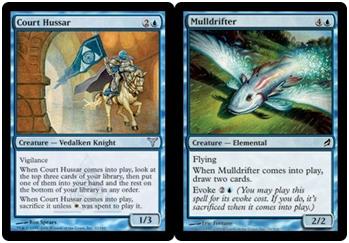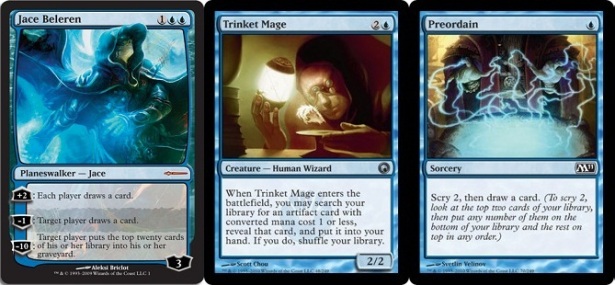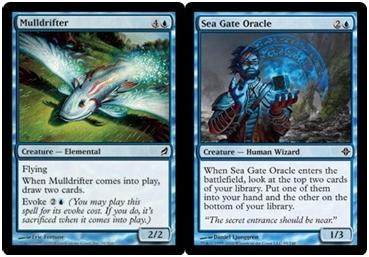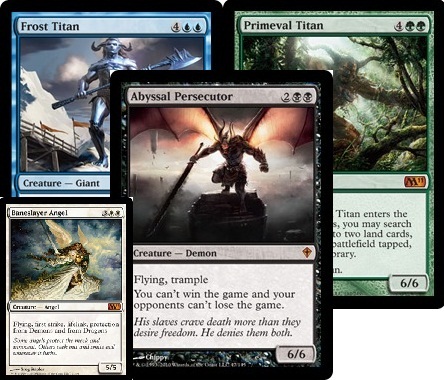If one thing is certain about the format, it’s that you have to have a plan to beat Jace, the Mind Sculptor. It seems that at least 50% of Top 8 decklists from any event have a set of Jaces. With the exception of the ramp decks, which are basically the combo decks of the format (and also on the decline), there are two categories of decks: Jace decks, and aggressive decks.
Since I’m a control player at heart, I want to talk about the Jace decks and the one I think is the best. Having won the last two StarCityGames.com Opens (same pilot, no less), U/G/r has certainly solidified itself among these, but I think there is another deck that deserves some attention. As an introduction to the deck, I want to analyze a card that I never thought I would care about playing. I think analyses like this are important in deckbuilding. However small they may seem, they are crucial in bringing the correct build to a tournament.
Sea Gate Oracle, What Is It Good For?
Court Hussar saw a fair amount of play during its heyday. Sea Gate Oracle is not Court Hussar, but the similarities between the two are hard to ignore. Both cost 2U, are 1/3s, and cantrip, while one has vigilance, digs a card deeper, and secretly costs W mana.
Even with the requirement to pay white, Court Hussar seems significantly better than its successor. So how is it possible to justify playing Sea Gate Oracle when it’s not even as good as Court Hussar?

|
Sea Gate Oracle might be Court Hussar’s grandson (with Mulldrifter in between), but the remaining 1,079 cards in Standard aren’t as easily comparable to the Ravnica Standard format. Instead of making a fairly pointless comparison, let’s analyze Sea Gate Oracle in the format for which it’s relevant.
Firstly, let’s go over what we’re getting out of Sea Gate Oracle:
- Provides slight card advantage/dig
- Blocks two-power creatures all day or chump-blocks a big creature
- Protects planeswalkers from attackers
- Provides a clock for opposing planeswalkers
According to this list, the primary reasons to play Sea Gate Oracle are to cantrip and defend from attackers, so the best place for Sea Gate Oracle is a control deck. Being able to attack for one is not very significant. Even attacking planeswalkers for one isn’t that amazing, but it’s something to keep in mind. Now, let’s take a look at what competes with Sea Gate Oracle for slots in our control decks:

Competing in the three-drop slot, Jace Beleren and Trinket Mage are both potent rivals. Jace acts as a Vindicate (a preemptive one, no less) to his older brother whereas Sea Gate Oracle only offers a weak clock against the Mind Sculptor. While
any
clock is better than
no
clock, a Jace that sticks around in control mirrors, even while being attacked for one, usually gives that player an advantage that’s difficult to overcome. Jace Beleren also has the potential to provide a steady stream of cards whereas Sea Gate Oracle is always the same cantrip plus a 1/3.
The only thing Sea Gate Oracle really does better than Jace Beleren is block 2/2s and interact with your other Jaces. Technically, Beleren cantrips and prevents some damage, just like Sea Gate Oracle, but Sea Gate Oracle does it better. And coupled with other Jaces, Beleren only serves to strand the Mind Sculptor in your hand while Sea Gate Oracle would offer some protection for it.
Consensus:
If you have few ways to protect Jace, the Mind Sculptor or are lacking against aggressive decks, Sea Gate Oracle might be better. If you want an edge in control mirrors, Jace Beleren is the way to go. U/B happens to have a general weakness to small creatures, so it would make some sense to include it over Jace Beleren.
Like Jace Beleren, Trinket Mage is also better than Sea Gate Oracle when facing down opposing Jaces (or any planeswalkers for that matter). Skullclamp showed us just how good +1/-1 could be, and Trinket Mage is no exception. The difference in the clock presented by and 2/2 vs. a 1/3 is tremendous. Had Sea Gate Oracle been a 2/2 with the same ability, it would be a lot harder to argue against it (the card would be sweet). But the way it is, we have to decide if +1/-1 is worth the room the artifacts take up in our decklist and the reduced capacity of cards we can “draw” off it. The standout artifacts are Everflowing Chalice, Elixir of Immortality, Brittle Effigy, and Chimeric Mass. Most of these cards are not that powerful. Adding them to your deck can create some possibility for weak draws (I’d relegate Elixir of Immortality to the sideboard). Specifically in U/B, Trinket Mage offers extra ways to answer Abyssal Persecutor (yours or your opponents), and that is a bonus I find hard to ignore.

|
Consensus:
Ultimately, I don’t think theory alone can break the tie. In testing, I found Sea Gate Oracle to be underwhelming and Trinket Mage to be worthwhile, so that’s my choice. It’s certainly worth trying both if you want to see which you prefer.
Preordain and Sea Gate Oracle compete for filtering slots, but there’s no real argument for Sea Gate Oracle. The reason Preordain is good is that it costs so little. The body just isn’t worth the two extra mana.
Consensus:
Everyone is already playing four Preordains. Preordain is just better and Sea Gate Oracle can only claim slots 5-8.
The overall consensus is that Sea Gate Oracle is generally not powerful enough to make the cut. Personally, I’ve always thought the card was too weak (some of my biases might have shown through in the analysis), and that’s why I was baffled when I saw this list at the top of the MOCS results (piloted by Prolepsis9):
Â
Creatures (9)
Planeswalkers (4)
Lands (25)
Spells (22)
Sideboard

First place in an event made up of only MTGO ringers is nothing to scoff at. I didn’t know it when I first saw it, but it turns out that the decklist actually came from Gerry Thompson, who played it at the last StarCityGames.com Open in Charlotte. You can read Gerry’s and
Prolepsis9’s respective tournament reports
here
and
here.
I talked with Gerry about the different things that stood out in the list. Most importantly, I wanted to find out why exactly he was playing Sea Gate Oracle. Gerry admitted that he hadn’t done much testing, but he felt that Sea Gate Oracle was best for what he wanted. Trinket Mage getting one of a few weak artifacts didn’t appeal to him, and he felt that Jace Beleren isn’t great in the mirror (which is where you’d want it) because of Creeping Tar Pit.
I see things differently. I think that being a 2/2 gives it enough of an advantage to warrant testing by itself, but then there are even the extra outs to Persecutor. Gerry said he didn’t need them, but I think it’s rather important to maximize them if you can afford to. In a deck without Persecutor, Sea Gate Oracle would make some sense, but in U/B I’m siding with Trinket Mage.
Jace Beleren can die to a Creeping Tar Pit, but even when it does, it’s still better than a Sea Gate Oracle would’ve been. You spent the same amount of mana to draw a card, but your opponent spent four mana and likely their whole turn to get rid of it. And if Jace sticks around or trades with another Jace, it’s obviously much better than Sea Gate Oracle. I’m not opposed to playing Sea Gate Oracle, but I think that the other two choices have at least equal merit. Gerry is currently down to two Sea Gate Oracles in his list without adding Jace Beleren or Trinket Mage.
Before I saw Gerry’s list, I had my own in which I was playing two Jace Belerens and zero Oracles or Trinket Mages. Since adopting his list, I’ve been testing with three Trinket Mages and one Jace Beleren and am not complaining. I gave Sea Gate Oracle a shot, but as expected it was underwhelming (having one under Mimic Vat is a rare sight). Luckily, there are plenty more things in Gerry’s list to mull over.
The New Frost Titan(s)
Abyssal Persecutor hasn’t gotten as much love as it supposedly deserves, but the card has proven to be worth the hype. Abyssal Persecutor laughs at Doom Blade, various Titans, and most other playable creatures. Titans are technically better, but Persecutor can threaten lethal before an opposing Titan even becomes an issue. It’s really hard to deal with, and it comes down as early as turn 3. U/B isn’t the control deck I’m used to. It is
much
faster, boasting seamless wins by turn 6 or 7! An unblockable 6/6 for four is good after all; it just needed a deck to fit into.

|
With three Abyssal Persecutors, Gerry chose to play eight answers to them. In my build I had four Persecutors and seven answers. I knew I was testing fate, but I didn’t care. I wanted to see how far I could go before I lost to my own card. Sometimes people will scoop to it regardless, but at one point my risky build finally caught up with me and cost me a match. I think eight answers should be sufficient for three Persecutors, but if you play the whole set, then you’ll want at least nine with some being able to answer multiple Persecutors, like Consuming Vapors and Ratchet Bomb. Jace, the Mind Sculptor technically counts, too, but it gives them an opportunity to kill it before you can bounce another Persecutor. Gerry is still at three Abyssal Persecutors.
Grave Titan was once considered to be the best Titan, but hype quickly faded in favor of Primeval Titan and Sun Titan. I think it’s become obvious that all of the Titans are good, even Inferno Titan, and they’re all bound to see play sooner or later. But Grave Titan has a pretty nice advantage over the others: it can’t be Doom Bladed. This is one of the reasons Gerry chose to play it over Frost Titan. He also felt that the aggro matchups would benefit from it over Frost Titan. Frost Titan is great against ramp decks, but the deck isn’t suffering against those decks.
Mimic Vat is another card that hasn’t seen much play yet, but is on everyone’s radar. Much like the previous two cards, it is having a tough time finding a deck to fit into, but it does fit well in decks with Doom Blade, and Gerry felt it would give him an edge in the mirror match (which he expected to be prevalent at the Open). The card has the potential to break games if all goes according to plan. Unfortunately, while testing the deck I found that it often didn’t pan out. The creatures in the U/B deck rarely find their way into the graveyard, and most opposing decks won’t have much worthwhile to put under it. It’s great in attrition matchups and games that go long, which is why I feel the card would fit better in the sideboard. Gerry still runs it, but is down to two copies.
The last thing that I had issue with in the maindeck was the three Everflowing Chalices. The deck doesn’t gain much from colorless sources, and the curve is much lower than that of typical control decks, but Gerry liked having the ability to cast one of the numerous four-drops a turn early. I can understand that advantage, but I think maxing out on Tectonic Edge in the main gives you an equally worthwhile advantage.
Gerry’s Sideboard
2 Dispel
For aggressive decks, Gerry included a set of Disfigures and three Consume the Meeks. I think Disfigure is a great card right now. There are lots of removal spells at two mana, but for one mana there’s only Disfigure. Costing only one can provide a lot of tempo. What does it kill? All one-drops, most two-drops, Spawn tokens, Elf lords, Vampires, black manlands, and Oracle of Mul Daya. So what if it doesn’t kill Sea Gate Oracle? Anything it doesn’t kill it can just shrink, which is not the case with Doom Blade. I think it’s relevant against enough decks that it’s worth playing 1-2 main, but Consume the Meek is far too narrow to warrant maindeck inclusion. It’s only good against a few decks, but it’s really good against those decks. Gerry chose to include so many cards for aggressive decks because game one can be difficult.
For counterspells, Gerry included two Dispels and two Flashfreeze. I’ve never liked Dispel. It seems incredibly narrow, and I don’t think it has any specific uses other than Summoning Trap, in which case I’d much rather have Spell Pierce and/or Mindbreak Trap. Most of the time Spell Pierce will be able to counter Summoning Trap, but it can also counter Cultivate, planeswalkers, and lots of other cards. It even fits well into this deck because this deck tends to end games quickly without getting into a drawn out “land-go” game (the mirror match being a fair exception). After Spell Pierce gets their first Summoning Trap, you can even cast Mindbreak Trap for free on the next one! And if you kindly ask your opponent to play all their Traps at once to save time (a la Cedric Phillips), you can even get a sweet two-for-one.
Sidebar
At a 1K two weeks ago, I was playing U/W Control against R/G Ramp in round 4 and was down a game. On turn 6, my opponent played his second Goblin Ruinblaster of the game, and I countered it. What does he do? He put two Summoning Traps on the stack. I look at my hand in disbelief. No Mindbreak Trap. He hit Wurmcoil Engine and Gaea’s Revenge. I wanted to tell him what could’ve just happened but would like to have a chance at pulling that play in the third game. Yes, there was a game 3.
End Sidebar
Mindbreak Trap can also play around Summoning Trap in a different way. Since it doesn’t actually counter a spell, your Trap traps their Trap… in their hand. Similarly, you can counter Gaea’s Revenge and Emrakul, the Aeons Torn with it.
Flashfreeze is also a little too narrow for my liking. It doesn’t counter Molten-Tail Masticore out of Mono-Red or Wurmcoil Engine/Eldrazi out of Eldrazi Ramp. Playing more than two is questionable, but two or less is okay.
Memoricide is a good way to
actively
disrupt the ramp decks. Their threats tend to be varied, but hitting the primary threat, Primeval Titan, is well worth it. Also, lowering their overall threat density makes Summoning Trap a lot worse. It’s typically not correct to bring in Memoricide against decks that don’t rely on a certain card, but getting a look at your opponent’s entire deck could make it worth bringing in when you otherwise shouldn’t.
The Updated List
After testing and refining the deck, this is where I’m at:
Creatures (8)
Planeswalkers (6)
Lands (26)
Spells (20)
- 4 Mana Leak
- 4 Doom Blade
- 1 Disfigure
- 1 Into the Roil
- 1 Spell Pierce
- 1 Everflowing Chalice
- 2 Consuming Vapors
- 1 Brittle Effigy
- 4 Preordain
- 1 Chimeric Mass
Sideboard

This version of the deck sacrifices some percentage against aggressive decks in an attempt to gain an advantage against the Jace decks. I haven’t done enough testing against U/G/r yet, but I think the matchup is good. The only answers they have to Grave Titan and Abyssal Persecutor aren’t very difficult for this deck to answer, and their threats are equally easy to answer. Admittedly, Frost Titan is probably better than Grave Titan against them, but we still have to be able to beat the aggressive decks, so for now Grave Titan keeps the slot.
The only cards worth noting in the sideboard are Basilisk Collar and Vampire Hexmage. Collar shores up the Mono-Red matchup and could also be boarded in against some of the other aggressive decks. It’s not necessarily better than Elixir of Immortality, but it works really well with Abyssal Persecutor. Hexmage isn’t just an answer to planeswalkers. It can also answer Ascensions, Everflowing Chalice, or just be a 2/1 first strike. It even handles Lotus Cobra while waiting around for Jace. The card is possibly worth more than one slot, but I needed the room.
The deck could certainly use some more work and testing, but I would be happy to play it in an upcoming event as is. If you’re planning on playing U/G/r, keep in mind that the deck is not one you want to just pick up and play. It’s a difficult deck to pilot. U/B on the other hand is not that difficult.
Michael Hetrick
_ShipItHolla
